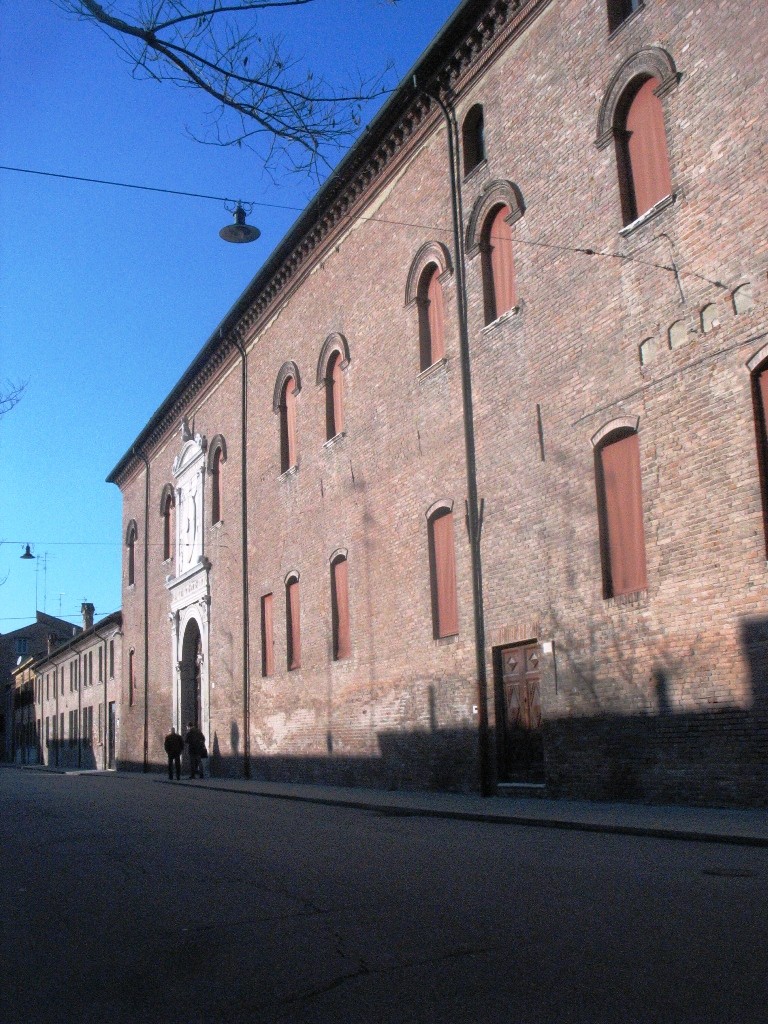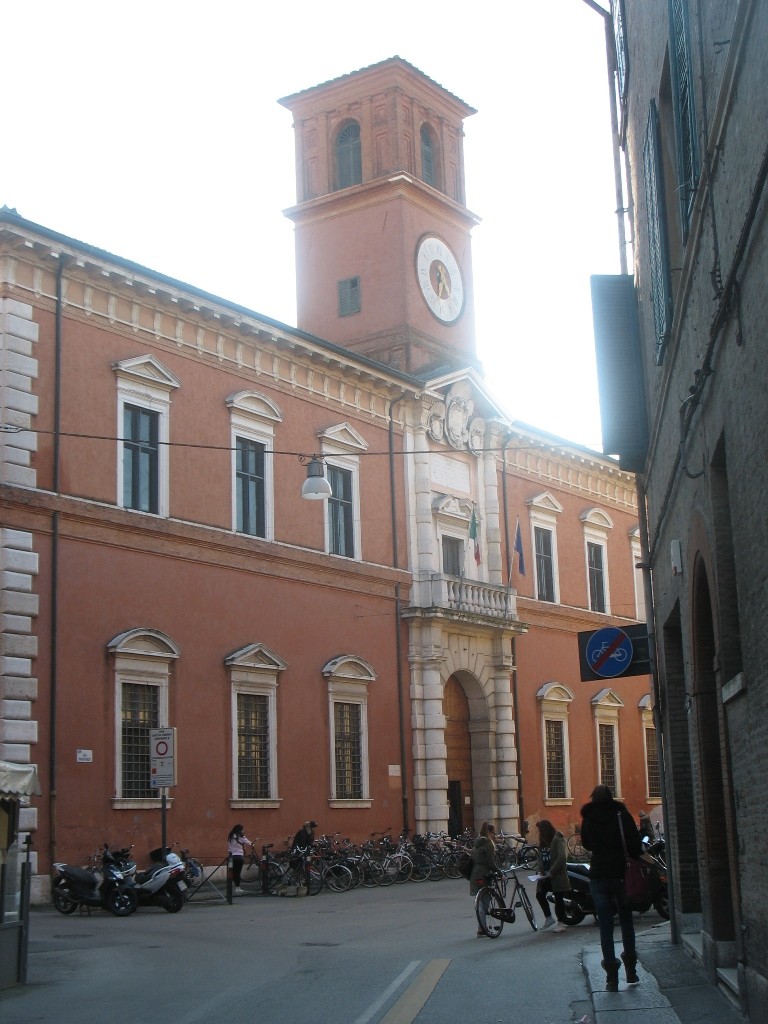A charming transition to the Renaissance
Resuming your tour from the church of San Giorgio, you will have to retrace your steps until reaching Palazzo Costabili, which has been described in the previous entry. Back into the city walls, the itinerary will go through a marvelous area of Ferrara, characterised by a series of amazing palaces and churches, most of which built in the late 15th century. A period of great splendor and expansion for the Este dukes, which marked the transition from the Middle Ages to the magnificence of the Renaissance.
Going past Palazzo Costabili, you will follow for a few metres via XX Settembre before turning right into via Borgovado. Walking along this street, you will finally find on the right one of the hidden treasure of Ferrara, the church of Santa Maria in Vado. Already a remarkable landmark for its artistic importance, the church is an unmissable attraction due to its great spiritual value. The primitive church dates back to the 10th century, when it was built near a ford ("vado") on the Po river. It was in this ancient place of worship that a clamorous miracle took place: during the Holy Mass, while the priest consecrated the holy bread, a gush of blood spurted from the host, staining the ceiling of the church. The present church is the result of a renovation carried out towards the end of the 15th century. Although, that piece of ceiling from the primitive church is still preserved, clearly bearing the marks of the bloodstains and certifying the miracle, which was also described in several chronicles of that time.

Leaving Santa Maria in Vado, there will be no need to go very far to find the next gem: a few steps for via Scandiana will lead you to Palazzo Schifanoia. Despite appearing rather unattractive and banal from the outside, the palace conserves a series of superb frescoes. Built in 1385, it was refurbished a few decades later by duke Borso d'Este. The original facade was lately replaced by the current one in red bricks, but as I have already mentioned the real attractions are found inside. In spite of the several damages they have suffered in the past centuries (including the recent earthquake), the frescoes are considered one of the best examples of Italian Renaissance paintings. They were realised by a group of painters belonging to the Ferrarese school, the most famous of whom were Cosmè Tura and Francesco del Cossa. In the Salone dei Mesi (Hall of Months), wonderful scenes depict the monthly activities of the common people, of the dukes and other noblemen, together with other symbols concerning astrology.
Back to the nearby crossroads in front of Santa Maria in Vado, you will go on the right for Via Madama, finally reaching the wide Corso Giovecca, the main artery of the town, which puts in connection the medieval part with the new districts built during the Renaissance. Though a stroll along this long avenue would be pleasant, you will need only a few steps on your right to find the next place worth visiting. It is a palace called Palazzina di Marfisa d'Este, taking its name from the daughter of the nobleman who commissioned the building. A fine example of aristocratic mansion of the 16th century, it still preserves most of the original f Months. Though of the original large garden very little is unfortunately left, the visit to this small palace is at any rate a delicious dive into the past. Walking back along Corso Giovecca, you will have the chance to have an open air break before embarking on the second part of the tour. On your left, indeed, you will find the entrance to Parco Pareschi, a quiet and relaxing oasis, perfect to enjoy a few minutes of rest in the sunshine. The park is located right behind Palazzo Renata di Francia, another 15th century palace. In this case you may spare yourself the visit, also due to the fact that it now houses the offices of the University of Ferrara.
Right opposite this palace, though, is located the far more interesting Casa Romei. Unlike most of the palaces described so far, this mansion was not meant for one of the members of the Este family. It was the banker Giovanni Romei, indeed, who commissioned it in the 15th century, though after his death the building became property of the adjacent Monastery of Corpus Domini. In addition to a few interesting frescoes, the inside boasts a magnificent yard, characterised by a superb double loggia with colonnade. Back to via Savonarola and heading for the centre, you will find on the opposite side of the street the remarkable church of San Francesco. Built between the end of the 15th and the beginning of the 16th century, by Biagio Rossetti. Inside the church you will find an atmosphere of peace and meditation, along with some interesting paintings preserved in the side chapels.
Opposite the side entrance to the church you will then take a narrow cobbled street, via Vecchie. From now on you will spend a few minutes immersed in the magic atmosphere of lonely narrow medieval streets, almost out of time and forgetful of the outer world. Once at the end of the street, you will be via Saraceno, emerging for a moment back to the civilized world before crossing the street and finding yourself in the loneliness of via Cavedone. Turning right towards via Cammello, you will find on your left the suggestive church of San Gregorio, whose presence was reported for the first time in 1085 (though obviously not with the current aspect). Taking the alley opposite the church, vicolo del Granchio, you will go by a gracious arcade and finally turn right into via Giuoco del Pallone. While walking along the street, don't fail to notice the fine colonnade on the right side.

The last noteworthy building of this stretch of the itinerary is Palazzo Paradiso, situated at the crossroads between via Scienze and via Giuoco del Pallone. Dating back to the end of the 14th century, it was converted in the following centuries into the seat of the university. As a demonstration of the prestige of the town in the late Middle Ages, it may be said that the palace housed in 1437-38 the first Ecumenical Council, whose members included even Pope Eugenio IV and the Emperor of Constantinople, Giovanni Paleologo. Among the illustrious personalities who graduated here, the great Suisse alchemist and astrologer Paracelsus, who is commemorated by a bust found in the inner staircase. Nowadays, the palace houses a public library, called Biblioteca Ariostea. Leaving your bag in custody to the reception and walking silently so as not to disturb students and readers, you may have a look at the inner garden and at first floor of the library, where the tomb of the great Ludovico Ariosto is preserved along with a series of ancient and precious volumes.
Photo gallery
Content available in other languages
Want to have your own Erasmus blog?
If you are experiencing living abroad, you're an avid traveller or want to promote the city where you live... create your own blog and share your adventures!
I want to create my Erasmus blog! →

















Comments (0 comments)